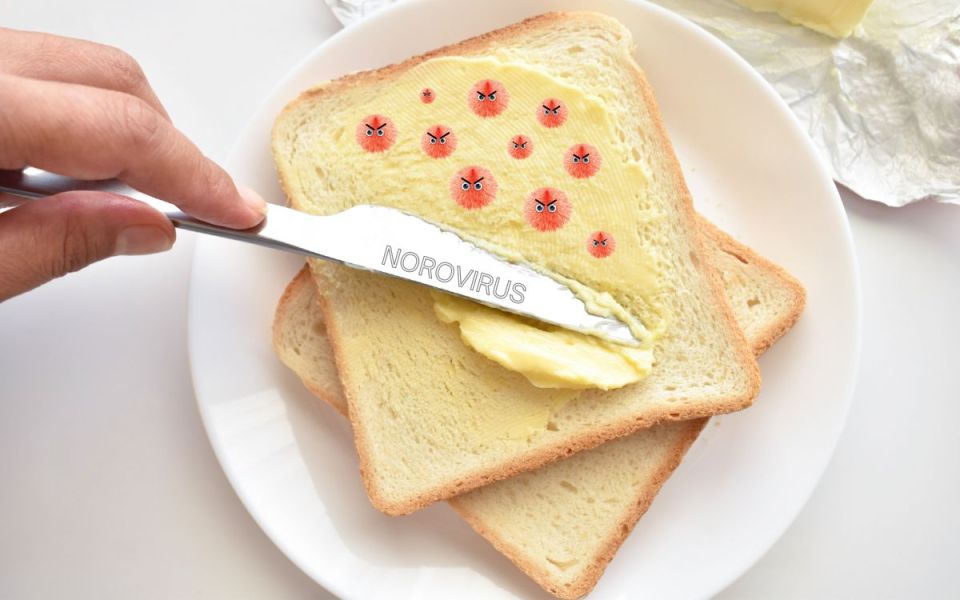Norovirus: Stomach Flu Spreading Like Room-Temperature Butter

Stomach flu is very unpleasant. It has the same symptoms as food poisoning and may indeed be caused by the same viruses. Rotavirus used to be the primary cause of stomach flu, before a successful vaccine was deployed around the turn of the millennium. Now, in an increasing number of cases, Norovirus is the culprit. This is a widespread virus, causing at least 70,000 deaths a year across the globe. Unlike other stomach bugs, this one infects and causes symptoms in people of all ages. Researchers have found that children comprise most of the cases, but those above 65 years of age have the highest chance of death.
The symptoms are those of any stomach flu or food poisoning, including dehydration, vomiting, diarrhea, and cramps. Together these are called acute gastroenteritis. Gastro- is Greek for “stomach,” enter- comes from “enteric,” which is Greek for “intestine,” and -itis means “inflammation of”. Gastroenteritis is an inflammation of the stomach and intestine. Clinical trials for acute gastroenteritis are ongoing. Occasionally non-intestinal symptoms are present, including headache, chills, and muscle aches. Symptoms vary by age, with children more prone to “lose their lunch” and adults more likely to “liquidate their assets”. Most people recover from a norovirus infection in one to three days.
Unfortunately, infection rates for norovirus are quite high. The virus is both infectious and hardy. People infected with norovirus can shed billions of norovirus particles. A person has a 50% chance of infection with just a single norovirus particle. The virus can survive in the environment for days and in temperatures from freezing to 140 degrees. This makes it particularly dangerous for closed and institutional settings, like schools, nursing homes, and cruise ships. It can also survive on raw oysters, in swimming pools and drinking water, and on fruits and vegetables irrigated with contaminated water. Clinical trials are looking to find vaccines to help protect against developing acute gastroenteritis from norovirus.
So, much like room-temperature butter, norovirus spreads with little effort. Also like butter, the best way to clean up is with soap and water. Norovirus is spread through direct contact with an infected person, contaminated food or water consumption, and contact with contaminated surfaces. Hand washing, disinfecting food surfaces, and social distancing are the current best practices for reducing the spread. Unfortunately, there are no specific treatments for a norovirus infection yet. Typical treatments include drinking plenty of fluids with electrolytes and taking probiotics. However, there is hope of a vaccine through the clinical research process. With luck, a norovirus vaccine may knock this virus off of its unfortunate pedestal just like rotavirus.
To learn more about norovirus and a possible vaccine, cruise on into your nearest clinical research office or give them a call! If your local research office does not have the trials you are interested in, visit clinicaltrials.gov.
Staff Writer / Editor Benton Lowey-Ball, BS, BFA
Click Below for ENCORE Research Group's Enrolling Studies
Refences:
Bányai, K., Estes, M. K., Martella, V., & Parashar, U. D. (2018). Viral gastroenteritis. The Lancet, 392(10142), 175-186. https://doi.org/10.1016%2FS0140-6736(18)31128-0
Glass, R. I., Parashar, U. D., & Estes, M. K. (2009). Norovirus gastroenteritis. New England Journal of Medicine, 361(18), 1776-1785. https://doi.org/10.1056%2FNEJMra0804575
Teunis, P. F., Moe, C. L., Liu, P., E. Miller, S., Lindesmith, L., Baric, R. S., ... & Calderon, R. L. (2008). Norwalk virus: how infectious is it?. Journal of medical virology, 80(8), 1468-1476. https://doi.org/10.1002/jmv.21237



